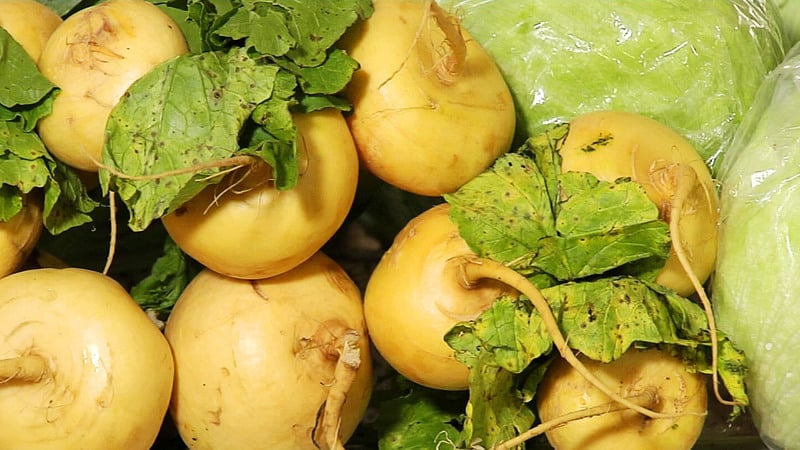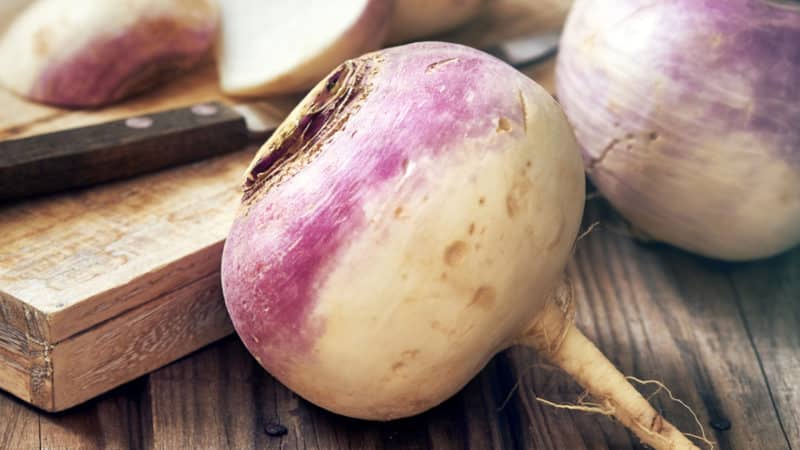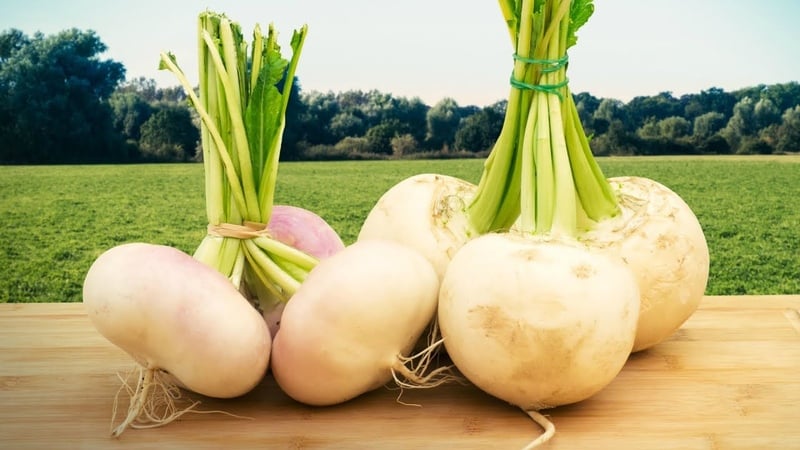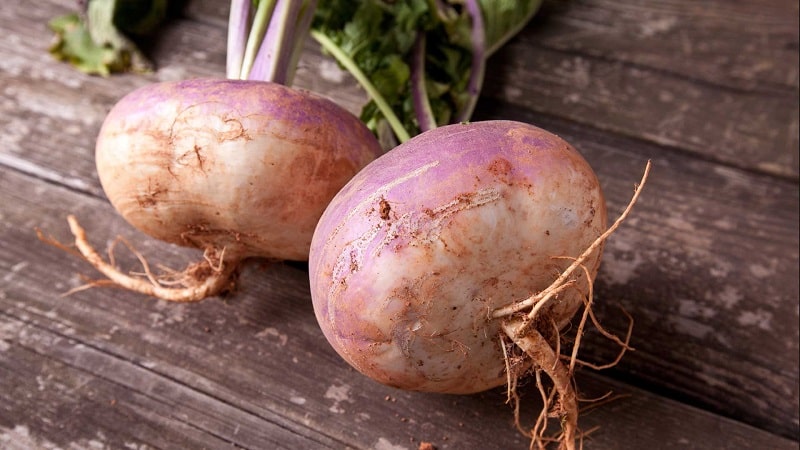What is the difference between rutabaga and turnip and how to tell them apart
In the century before last, turnips were the main remedy for rickets and bone and blood diseases due to their high calcium content. Rutabaga was used not only in nutrition, but also in the treatment of coughs. Their beneficial properties have long been studied, and now they are again appearing in our diet. You will learn from the article how one vegetable differs from another.
Difference between rutabaga and turnip
Turnip is a herbaceous annual or biennial plant of the Brassica family. The edible root grows already in the first year of sowing. The turnip's stem is tall and has many leaves. The whole plant is green, the inflorescences are yellow. The history of growing this crop goes back 4000 years; it was cultivated in Ancient Greece and Egypt. Then it was considered the food of slaves and peasants.
In Russia, the vegetable was an important food product and was mentioned in ancient chronicles. Only in the 18th century was it gradually replaced by potatoes. Turnips are sown as soon as the soil dries, in early spring in a sunny place. Light loamy soil is suitable for this crop.

Swede is a biennial plant from the Brassica family. It was first described by the Swiss botanist Caspar Baugin in 1620, which is why it is sometimes called the Swedish turnip. According to another version, the plant appeared in Siberia, from where it spread to the Scandinavian countries: Sweden, Germany and Finland.
Rutabaga is considered a hybrid of wild cabbage and turnip. The seeds of this cold-resistant vegetable germinate at temperatures of +1...+3 °C and can withstand short-term cooling down to -4 °C.With prolonged heat and drought, the fruits become tasteless. Therefore, the crop is planted early and grown before the onset of summer. The stem of rutabaga is tall, straight, and leafy. The lower leaves are pinnately cut. The whole plant is bluish in color, the inflorescences are yellow.

Both vegetables are cold-resistant and early ripening.. During the summer you can get two harvests of turnips. This crop has short pods, red-brown, spherical seeds. Rutabaga seeds are dark brown balls with a diameter of up to 1.8 mm.
Plants differ from each other in shape and color. The shape of rutabaga depends on the variety. There are root vegetables of round, cylindrical or round-flat shape. The upper part of the fruit, protruding above the ground, is gray or purple, the lower part is yellow. The pulp is pale orange.
The turnip has a rounded-flat shape, inside and outside it is golden yellow in color.. The weight of one root crop varies from 60 to 500 g, and the weight of rutabaga varies from 300 g to 2 kg, depending on the variety. The first one tastes a little sweeter than cabbage stalks. Rutabaga is something between a turnip and cabbage, and when cooked it looks like a potato.
Difference in chemical composition
What is the difference between rutabaga and turnip? Vegetables are similar in composition, but the first one is more nutritious.
100 g of rutabaga contains:
- calories - 37;
- proteins - 1.2 g;
- fats - 0.1 g;
- carbohydrates - 7.7 g;
- dietary fiber - 2.2 g;
- water - 88 g.
Rutabaga contains more than turnips:
- gland;
- vitamin C.
The vegetable also contains more vitamin B2, vitamin P and nicotinic acid.
This is interesting:
Useful properties and contraindications of rutabaga
What vitamins are in radishes and why are they good for health?
Review of the best radish varieties for open ground and greenhouses
100 g of turnip contains:
- calories - 32;
- proteins - 1.5 g;
- fats - 0.1 g;
- carbohydrates - 6.2 g;
- dietary fiber - 1.9 g;
- water - 90 g.

There's a turnip:
- succinic acid;
- glucoraphanin, which when chewed is converted into sulforaphane, a natural antibiotic and a powerful anti-cancer organic compound.
Both vegetables replenish vitamin deficiencies, especially in winter and early spring., and serve as an excellent diuretic, anti-inflammatory, and laxative. The juice of these vegetables is a natural antiseptic, so it is effective for sore throat.
Turnip stimulates cardiac activity and enhances the secretion of gastric juice, is useful for diabetes (its glycemic index is 15 units), reduces blood sugar levels. Rutabaga, on the contrary, is better to exclude for this disease due to its high glycemic index of 70 units. The vegetable is used as an anti-burn agent and included in therapeutic nutrition for atherosclerosis.
Attention! Both vegetables can harm the body in acute diseases of the gastrointestinal tract due to the large amount of fiber, which irritates the mucous membrane.
If there are no stomach problems, vegetables are good for constipation.
Rutabaga is used boiled, fried and stewed in stews, pies, side dishes for meat. Turnips are baked, boiled, stuffed, used fresh in casseroles, stews and salads.
What's better
Rutabaga is more caloric and nutritious, contains more vitamins, iron and phosphorus. Turnips are rich in calcium, magnesium and sodium. Vegetables have slight differences in taste, so your purchase should be based on personal preference.
If you have your own garden, you can harvest a double harvest of turnips. The first time it is sown in early May, the second - in early July. Turnips of the second sowing are used for winter storage.Rutabaga is a later ripening crop: it takes 3 to 4 months from sowing to ripening.
Are rutabaga and turnip the same thing?
Turnip is a subspecies of the turnip species., which was originally grown to feed livestock. Later, varieties were bred for human consumption. Now there are various types of turnips with a pleasant taste: Purple turnip, Golden ball, Snowflake, Japanese turnip, Orange jelly.

There is not much difference in composition between rutabaga and turnip, but the latter is distinguished by a large amount of vitamin K, which has a positive effect on blood vessels and blood clotting.
Externally, the vegetable has practically no differences from ordinary rutabaga. Its advantages include excellent adaptability to climate change and high productivity. For the summer table, turnips are planted in early spring, for winter storage - in the first half of July. Dietary salads, soups and sauces are prepared from the fruit.
Conclusion
Rutabagas and turnips are members of the same Brassica family. However, there are slight differences in their chemical composition (rutabaga is more nutritious), taste, application and cultivation (turnips are planted 2 times per summer). Turnips, as one of the subspecies of turnips, are added raw to salads.
It is important to remember that, despite all their usefulness, these vegetables are excluded from the diet during exacerbation of gastrointestinal diseases. Diabetics may benefit from eating turnips to regulate blood sugar, while rutabaga is best avoided due to its high glycemic index.